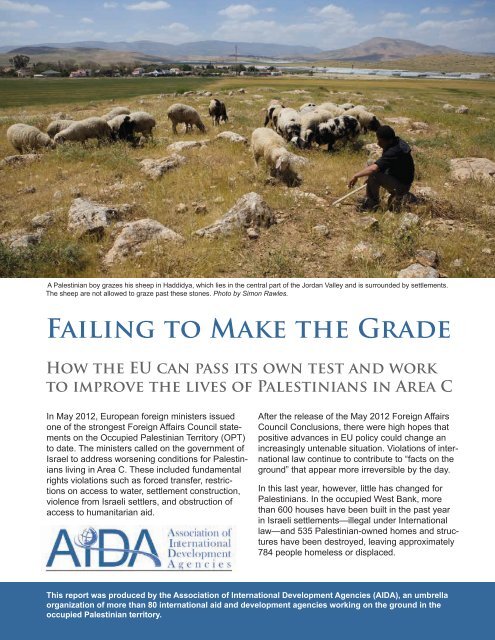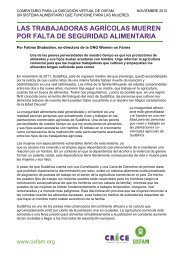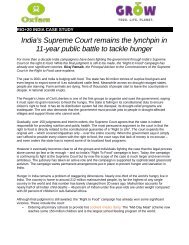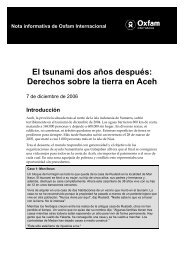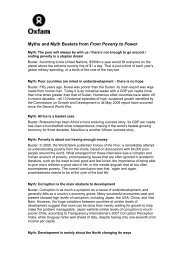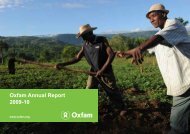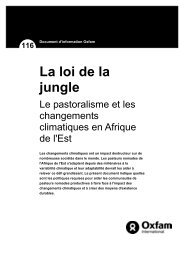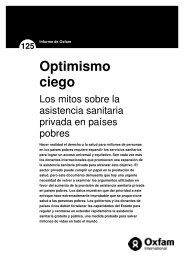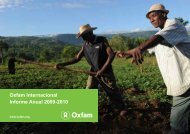Failing to Make the Grade (English full report) - Oxfam International
Failing to Make the Grade (English full report) - Oxfam International
Failing to Make the Grade (English full report) - Oxfam International
You also want an ePaper? Increase the reach of your titles
YUMPU automatically turns print PDFs into web optimized ePapers that Google loves.
A Palestinian boy grazes his sheep in Haddidya, which lies in <strong>the</strong> central part of <strong>the</strong> Jordan Valley and is surrounded by settlements.The sheep are not allowed <strong>to</strong> graze past <strong>the</strong>se s<strong>to</strong>nes. Pho<strong>to</strong> by Simon Rawles.<strong>Failing</strong> <strong>to</strong> <strong>Make</strong> <strong>the</strong> <strong>Grade</strong>How <strong>the</strong> EU can pass its own test and work<strong>to</strong> improve <strong>the</strong> lives of Palestinians in Area CIn May 2012, European foreign ministers issuedone of <strong>the</strong> strongest Foreign Affairs Council statementson <strong>the</strong> Occupied Palestinian Terri<strong>to</strong>ry (OPT)<strong>to</strong> date. The ministers called on <strong>the</strong> government ofIsrael <strong>to</strong> address worsening conditions for Palestiniansliving in Area C. These included fundamentalrights violations such as forced transfer, restrictionson access <strong>to</strong> water, settlement construction,violence from Israeli settlers, and obstruction ofaccess <strong>to</strong> humanitarian aid.After <strong>the</strong> release of <strong>the</strong> May 2012 Foreign AffairsCouncil Conclusions, <strong>the</strong>re were high hopes thatpositive advances in EU policy could change anincreasingly untenable situation. Violations of internationallaw continue <strong>to</strong> contribute <strong>to</strong> “facts on <strong>the</strong>ground” that appear more irreversible by <strong>the</strong> day.In this last year, however, little has changed forPalestinians. In <strong>the</strong> occupied West Bank, morethan 600 houses have been built in <strong>the</strong> past yearin Israeli settlements—illegal under <strong>International</strong>law—and 535 Palestinian-owned homes and structureshave been destroyed, leaving approximately784 people homeless or displaced.This <strong>report</strong> was produced by <strong>the</strong> Association of <strong>International</strong> Development Agencies (AIDA), an umbrellaorganization of more than 80 international aid and development agencies working on <strong>the</strong> ground in <strong>the</strong>occupied Palestinian terri<strong>to</strong>ry.
While a number of EU institutions and member stateshave issued strong statements in reaction <strong>to</strong> <strong>the</strong>se developments,European responses <strong>to</strong> ongoing demolitionsof homes, schools and o<strong>the</strong>r basic infrastructure remainad-hoc and uncoordinated. And, despite a handful of initiativesby individual EU member states, Europe’s leadersare still reluctant <strong>to</strong> raise collectively and systematicallywith <strong>the</strong>ir Israeli counterparts <strong>the</strong> need for fundamentalchanges <strong>to</strong> Israeli government policies that harm Palestinianrights and development in Area C. *Over 60 percent of <strong>the</strong> occupied West Bank is designatedas “Area C,” meaning it falls under <strong>full</strong> Israeli governmentmilitary and civil control. An estimated 150,000 Palestinianslive in Area C, with approximately 325,000 Israelisliving in settlements. 1Area C is home <strong>to</strong> some of <strong>the</strong> most vulnerable Palestiniancommunities. They struggle <strong>to</strong> build simple homes,graze sheep and goats, make a living and raise <strong>the</strong>irchildren. This is very difficult, however, without regularaccess <strong>to</strong> land, water and basic services such as schools,medical facilities and a responsive police force. Isolated* We focus here on EU–Israeli relations because that is <strong>the</strong> focus of <strong>the</strong>FAC conclusions and of recent EU Heads of Mission <strong>report</strong>s. The EUand Israel hold a structured dialogue on human rights by virtue of <strong>the</strong>irAssociation Agreement. AIDA condemns violence against civilians on allsides and calls on all parties <strong>to</strong> <strong>the</strong> conflict <strong>to</strong> uphold <strong>the</strong>ir obligations inline with international law.from services provided by <strong>the</strong> Palestinian Authority ino<strong>the</strong>r parts of <strong>the</strong> West Bank, Palestinians living in Area Crely heavily on humanitarian and development assistance.Members of <strong>the</strong> Association of <strong>International</strong> DevelopmentAgencies (AIDA), an umbrella organization of more than80 international aid and development agencies workingon <strong>the</strong> ground in <strong>the</strong> OPT, are urging EU member states<strong>to</strong> act now <strong>to</strong> reinforce <strong>the</strong>ir strong statements with coordinated,systematic action backed by high-level politicalleadership in order <strong>to</strong> protect <strong>the</strong> most vulnerable Palestiniancommunities.This <strong>report</strong> examines developments since <strong>the</strong> Foreign AffairsCouncil conclusions in four areas (those that addressArea C and settlements) that pose immediate problemsfor <strong>the</strong> work of AIDA members. 2 The <strong>report</strong> assesses EUand members states’ performance over <strong>the</strong> year since<strong>the</strong> conclusions and proposes actions <strong>the</strong>y can take <strong>to</strong>improve <strong>the</strong> lives of Palestinians in <strong>the</strong> OPT, especiallyArea C.By using collective strength and political will, <strong>the</strong> EU andits member states can and should change conditions on<strong>the</strong> ground. Suggestions for how <strong>the</strong> EU and its memberstates can come <strong>to</strong>ge<strong>the</strong>r <strong>to</strong> create this change and improve<strong>the</strong> lives of vulnerable men, women, and children inArea C are summarized in <strong>the</strong> table below.A Palestinian girl passes <strong>the</strong> time in her family’s tent. Palestinians face great difficulties in obtaining Israeli construction permits <strong>to</strong> buildhomes, schools, roads, water networks, or electricity grids in <strong>the</strong> Jordan Valley, which is mostly Area C. Pho<strong>to</strong> by Simon Rawles.2
EU Commitments & Performance on Area CDemolitions & DisplacementWhat <strong>the</strong> EU saidin May 2012What’s happenedsince“The EU calls upon Israel <strong>to</strong> meet its obligations” which include “halting forced transfer ofpopulation and demolition of Palestinian housing and infrastructure, simplifying administrativeprocedures <strong>to</strong> obtain building permits, ensuring access <strong>to</strong> water and addressing humanitarianneeds.”• y 94% rejection rate for Palestinian requests for building permits.• y demolition of 535 Palestinian-owned structures in <strong>the</strong> West Bank (including residentialstructures, emergency tents, livelihood infrastructure, water cisterns, and roads). Of<strong>the</strong>se demolitions, 464 occurred in <strong>the</strong> West Bank and 71 in East Jerusalem, forciblydisplacing 784 people, of whom more than half were children.Significantly improve EU-wide coordination of preventative and responsive actions <strong>to</strong> protectPalestinians from displacement and demolitions, including:What can andshould be done• y systematic high-level political action by European governments (for example,demarches, statements, and if necessary recalling ambassadors from Tel Aviv);• y providing insurance or budget allocations <strong>to</strong> allow demolished structures <strong>to</strong> be rebuilt;• y providing diplomatic convoys for aid agencies that support Palestinians living in areasunder heavy Israeli restrictions; and• y advocating for <strong>the</strong> right of displaced people <strong>to</strong> return <strong>to</strong> <strong>the</strong>ir land and be compensatedfor any harm and damages <strong>the</strong>y may have suffered.Discrimination in Permits & PlanningWhat <strong>the</strong> EU saidin May 2012What’s happenedsinceWhat can andshould be done“The EU calls upon Israel <strong>to</strong> meet its obligations regarding <strong>the</strong> living conditions of <strong>the</strong> Palestinianpopulation in Area C, including by accelerated approval of Palestinian master plans…”• y Of 32 master plans funded by <strong>the</strong> EU since 2009, none have been approved by Israeliauthorities. Without master planning, communities develop in an ad hoc way that doesnot support <strong>the</strong>ir development. They are also left vulnerable <strong>to</strong> Israeli demolitions.• y Much of Area C is still out of bounds for Palestinian development due <strong>to</strong> Israeli restrictions.Hundreds of Palestinian villages remain outside of development plans and <strong>the</strong>reforecannot proceed with construction, growth and service provision.• y Adopt a clear European policy of starting <strong>to</strong> build development infrastructure in areaswhere master plans were submitted more than 18 months prior, even if <strong>the</strong> plans remainunapproved.• y Move forward with aid projects in localities where master plans have not yet beendeveloped if <strong>the</strong>re is no response from Israeli authorities <strong>to</strong> building permit applicationswithin six months of submission, or if objections are not related <strong>to</strong> minimal technicalstandards or legitimate security concerns.• y Increase support for new, comprehensive Palestinian national development and spatialplans in order <strong>to</strong> address planning in a coherent manner.3
SettlementsWhat <strong>the</strong> EU saidin May 2012What’s happenedsince“Settlements remain illegal under international law… The EU condemns continuous settlerviolence and deliberate provocations against Palestinian civilians. It calls on <strong>the</strong> governmen<strong>to</strong>f Israel <strong>to</strong> bring <strong>the</strong> perpetra<strong>to</strong>rs <strong>to</strong> justice and <strong>to</strong> comply with its obligations under internationallaw.”• y 1,967 settlement housing units were included in new Israeli tendering processes and613 new housing units have already been built. This represents a significant increaseover previous years.• y 150 Palestinians were injured by settlers, including 33 children.Press for an immediate halt <strong>to</strong> settlements.What can andshould be doneEstablish a systematic moni<strong>to</strong>ring and response plan <strong>to</strong> address settler violence that ensures<strong>the</strong> government of Israel is upholding its obligation <strong>to</strong> protect Palestinian civilians and<strong>the</strong>ir property by:• y investigating in a systematic, timely, and transparent manner alleged incidents of settlerviolence;• y prosecuting known perpetra<strong>to</strong>rs; and• y ensuring victims have access <strong>to</strong> effective remedy and justice.Hindering EU-funded AssistanceWhat <strong>the</strong> EU saidin May 2012What’s happenedsinceWhat can andshould be done“The EU will continue <strong>to</strong> provide financial assistance for Palestinian development in AreaC and expects such investment <strong>to</strong> be protected for future use. The EU will engage with <strong>the</strong>Government of Israel <strong>to</strong> work out improved mechanisms for <strong>the</strong> implementation of <strong>the</strong> donorfunded projects for <strong>the</strong> benefit of <strong>the</strong> Palestinian population in Area C.”• y 30 European-funded structures have been demolished by Israel authorities.• y No European donor has sought compensation for damage <strong>to</strong> EU-funded aid projects, orpressed for accountability by o<strong>the</strong>r means.• y Support for community resilience projects is extended, but little support has been offeredfor infrastructure development that benefits Palestinians in Area C.• y Collectively demand compensation for damage <strong>to</strong> European-funded aid projects.• y Ensure adequate financing is available for development activities that benefit Palestiniancommunities in Area C, including for <strong>the</strong> construction of infrastructure.4
Demolitions & DisplacementOne of <strong>the</strong> most basic needs—housing—is in short supplyfor Palestinians in Area C. Only one percent of land <strong>the</strong>reis currently available for Palestinian construction. Potentialdevelopment is restricted in most of Area C due <strong>to</strong><strong>the</strong> presence of illegal Israeli settlements, Israeli militaryzones, <strong>the</strong> Wall, and o<strong>the</strong>r restrictions imposed by <strong>the</strong>Israeli government. 3Moreover, when Palestinians seek <strong>to</strong> build, <strong>the</strong>y are generallydenied permission. Israeli authorities have grantedless than 6 percent of construction permits requestedby Palestinians over <strong>the</strong> past decade. 4 Without buildingpermits, residents ei<strong>the</strong>r build anyway or resort <strong>to</strong> livingin makeshift shacks and tents that offer little protectionagainst <strong>the</strong> winter’s cold rain or summer heat. ManyPalestinian communities have felt <strong>the</strong>y had no choice but<strong>to</strong> build essential structures without permits, which in turnleaves <strong>the</strong>ir schools, homes and agricultural structuresvulnerable <strong>to</strong> demolition.“The humanitarian community reiterates itscall <strong>to</strong> <strong>the</strong> Government of Israel <strong>to</strong> immediatelyhalt demolitions of Palestinian homes andproperty and <strong>to</strong> establish a fair and equitablezoning and planning system. […] Israel, as anoccupying power, has an obligation under internationallaw <strong>to</strong> protect Palestinian civiliansand <strong>to</strong> administer <strong>the</strong> terri<strong>to</strong>ry in a manner thatensures <strong>the</strong>ir welfare and basic needs.”“—Maxwell Gaylard, UN Humanitarian Coordina<strong>to</strong>rfor <strong>the</strong> Occupied Palestinian Terri<strong>to</strong>ry andDeputy Special Coordina<strong>to</strong>r for <strong>the</strong> Middle EastPeace ProcessBetween May 2012 and April 2013, Israeli authoritiesdestroyed 535 Palestinian-owned structures (includingresidential structures, emergency tents, livelihood infrastructure,water cisterns, and roads), displacing 784people, of whom more than half were children. Of <strong>the</strong>sedemolitions, 464 occurred in <strong>the</strong> West Bank and 71 inEast Jerusalem. 50 50 100 150 200 250 300StructuresDemolishedTotal No. ofPeopleDisplacedChildrenDisplacedMay‘12June‘12July‘12Aug‘12Sept‘12Oct‘12Nov‘12Dec‘12Jan‘13Feb‘13March‘1350 67 18 49 5 83 35 25 140 13 2 48 53565 86 6 45 6 135 29 33 257 48 10 64 78442 40 0 23 3 87 14 10 156 23 5 38 441April‘13Total5
The human <strong>to</strong>ll of <strong>the</strong>se demolitions is enormous, disruptingchildren’s education, separating family members,and causing <strong>the</strong> declining economic, physical and mentalhealth of <strong>the</strong> families that experience <strong>the</strong>m. 6 According <strong>to</strong><strong>the</strong> Geneva Conventions, demolition in occupied terri<strong>to</strong>ryis illegal and <strong>the</strong> extensive destruction of property mayconstitute a grave breach of <strong>the</strong> Fourth Geneva Convention.7In July 2011, <strong>the</strong> EU Heads of Mission in Jerusalem recommendedthat, as a first step <strong>to</strong> preventing Palestiniandisplacement, <strong>the</strong> EU and its member states should “moresystematically voice objections <strong>to</strong> involuntary populationmovements, displacements, evictions, demolitions andinternal migration.” 9The EU and its member states have not yet done so on asystematic basis, nor at <strong>the</strong> ministerial level. So far suchobjections have been voiced only sporadically. In 2011,for instance, Poland issued a démarche and called <strong>the</strong>Israeli ambassador for a meeting with <strong>the</strong> Polish Ministryof Foreign Affairs after repeated demolitions of cisternsrehabilitated by Polish funds. Similarly, in April 2012,France confronted Israel’s ambassador in Paris over <strong>the</strong>demolition of two water cisterns in Hebron in <strong>the</strong> sou<strong>the</strong>rnWest Bank that were financed under a French agriculturalcooperation project. These remain, however, <strong>the</strong> exceptionsthat prove <strong>the</strong> rule.DEMOLITIONS ON THE RISEJanuary 2013 witnessed a spike in demolitions:140 Palestinian structures including 59 residentialstructures were demolished—<strong>the</strong> highest numberin a single month in over two years, and an almostthree-fold increase compared with <strong>the</strong> monthlyaverage of demolitions in 2012 and 2011. Nearly90 percent of January’s demolitions <strong>to</strong>ok place inArea C. 8Just three months later, between April 23-30, Israelibulldozers destroyed 36 basic Palestinian homesand structures across Area C and East Jerusalem,including five emergency shelters <strong>the</strong> French Consulateprovided for families who were left homelessin <strong>the</strong> nor<strong>the</strong>rn Jordan Valley by <strong>the</strong> Israeli demolitionsin January. During <strong>the</strong> same week, <strong>the</strong> Israelimilitary temporarily displaced at least 70 Palestinianfamilies from six different villages in <strong>the</strong> Jordan Valley<strong>to</strong> conduct military training drills.The EU currently lacks a coherent response <strong>to</strong> preventingand responding <strong>to</strong> demolitions and displacement in <strong>the</strong>OPT. It can and should develop an EU-wide systematicresponse plan <strong>to</strong> address harmful policies by <strong>the</strong> Israeligovernment and support <strong>the</strong> most vulnerable.BLOCKING EDUCATIONRestrictions on development in Area C are affecting children’s access <strong>to</strong> education, a right enshrined in <strong>the</strong> Conventionon <strong>the</strong> Rights of <strong>the</strong> Child 10 <strong>to</strong> which Israel is a signa<strong>to</strong>ry, as well as o<strong>the</strong>r instruments of international law.Restrictions on building in Area C have resulted in a shortage of classrooms and community-based primary schools,meaning that young children often walk long distances <strong>to</strong> get <strong>to</strong> school. On <strong>the</strong> way, <strong>the</strong>y face settler and military violence,checkpoints, and <strong>the</strong> risk of being detained. Girls are often kept at home because parents fear for <strong>the</strong>ir safety.In Khan al Ahmar, a Bedouin community located in <strong>the</strong> politically-sensitive Jerusalem periphery known as E1, parents,children, and international donors sought <strong>to</strong> avoid building restrictions by assembling a sturdy school built from car tiresand mud.On June 23, 2009, Israeli authorities issued <strong>the</strong> first s<strong>to</strong>p work and demolition orders against <strong>the</strong> school because nobuilding permit had been obtained. With legal aid, <strong>the</strong> community has managed <strong>to</strong> delay demolition, but still faced aseries of legal and physical challenges. These include <strong>the</strong> confiscation of school materials, attacks and harassment bysettlers, and <strong>the</strong> blocking of school access through road works and a barrier at <strong>the</strong> community entrance.At right: A boy plays outside his home in Khan al Ahmar, which sits between <strong>the</strong> Jordan Valley and Jerusalem. Like <strong>the</strong> school, his family’ssimple shack made from plastic and tin has been issued a demolition order because it was erected without permission from <strong>the</strong> Israeliauthorities. Pho<strong>to</strong> by Simon Rawles.6
RESTRICTING ACCESS TO WATERSaid is a 47-year old farmer from Al Fawwar, a refugeecamp south of Hebron. He owns a small plo<strong>to</strong>f land in Area C, just outside his village, where hegrows olives, almonds, grapes, cherries and plums.Most of this produce feeds his large family of ninechildren, with some also sold in <strong>the</strong> village <strong>to</strong> augmenthis job as a construction worker in Israel.In 2007, Said built a large 240 m³ capacity cisternon <strong>the</strong> hillside in his fields <strong>to</strong> collect rainwater thatspills from <strong>the</strong> hills during <strong>the</strong> rainy season. He usedit <strong>to</strong> irrigate his trees through <strong>the</strong> dry summer.At 5:15 am on April 29, 2013, a convoy of Israeliarmy jeeps and a bulldozer demolished his cistern,filling it with earth, rubble and uprooted treesin <strong>the</strong> process. Building <strong>the</strong> cistern had cost himapproximately 40,000 NIS (about $11,000), and nowclearing and rebuilding it would cost perhaps 60,000NIS ($16,800).“I can´t afford <strong>to</strong> build a new cistern,” he says, “sofor now I will have <strong>to</strong> buy water brought by truck, butit won´t be enough. My vines will surely die, and Ijust planted small olive trees that need <strong>to</strong> be wateredevery two weeks.”Discrimina<strong>to</strong>ry Planning & PermitsAll over <strong>the</strong> world, <strong>to</strong>wns and cities are built with properurban planning in mind. In most areas, forums for planningand zoning consider future development againstcurrent public needs and <strong>the</strong>n decide where <strong>to</strong> allot spacefor parks, businesses, and residential areas. In Area C,however, Palestinians have been largely excluded fromparticipating in such a planning process, because it iscontrolled by Israeli authorities. While Israel as <strong>the</strong> occupyingpower has an obligation <strong>to</strong> provide for <strong>the</strong> well-beingof <strong>the</strong> Palestinian population, it has not upheld this obligationand has hindered development and favored Israelisettlements at <strong>the</strong> expense of Palestinian communities.Without inclusive planning mechanisms, <strong>the</strong> needs ofordinary Palestinian men, women and children remainunaddressed. Many communities do not have adequatehousing, health clinics, or primary schools, and have noformal plan <strong>to</strong> prepare for future population growth, or <strong>to</strong>connect <strong>the</strong>m <strong>to</strong> water and electricity networks.While acknowledging <strong>the</strong> need for new infrastructure inArea C, most European donors have also been reluctant<strong>to</strong> fund such development in <strong>the</strong> absence of <strong>full</strong>yapproved “master plans” and building permits. They cite<strong>the</strong> increased risk of demolition. Recently, <strong>the</strong>refore, <strong>the</strong>international donor community has invested in <strong>the</strong> developmen<strong>to</strong>f master plans and committed <strong>to</strong> pushing forfairer systems for obtaining building permits. 117
THE LEGAL QUESTIONEven without final approval, <strong>the</strong> submission ofmaster plans seems <strong>to</strong> have temporarily halted <strong>the</strong>demolition of infrastructure in <strong>the</strong> handful of communitiesthat have developed such plans. 19 However,<strong>the</strong> process of creating master plans may legitimizean illegal system and de fac<strong>to</strong> “justify” demolitionsoutside of master planned areas, thus not serving <strong>to</strong>protect <strong>the</strong> most marginalized and vulnerable, suchas herding and mobile communities. 20The Israeli planning system in <strong>the</strong> West Bankmay itself be in breach of international law. 21 Thirdstates and international organizations are obliged<strong>to</strong> ensure that <strong>the</strong>y do not aid, assist or recognizesuch illegal Israeli policies and practices. Europeandonors’ current engagement (through implementingorganizations) with <strong>the</strong> Israeli planning andpermitting system in Area C may fall short of <strong>the</strong>serequirements. For example, master plans currentlyup for approval by Israeli authorities have de fac<strong>to</strong>recognized illegal Israeli policies and practices inArea C, such as <strong>the</strong> Wall and settlements. 22“The current planning process is at best as<strong>to</strong>p-gap solution for vulnerable communitiesliving in Area C and though some plans haveso far proved a successful short-term protection<strong>to</strong>ol, this is <strong>the</strong> case for only a handful ofcommunities. At worst, however, <strong>the</strong> process iscounterproductive: it risks creating a two-tieredhierarchy of Palestinian villages in Area C, giving<strong>the</strong> Israeli administration <strong>the</strong> choice of whichplans <strong>to</strong> discuss and which <strong>to</strong> reject or ignore.There is a huge risk that [Israeli authorities]could use planning <strong>to</strong> fur<strong>the</strong>r justify <strong>the</strong> displacemen<strong>to</strong>f communities which have not beenincluded in <strong>the</strong> system.“—Alon Cohen-Lifshitz, planner working at Bimkom– Planners for Planning Rights, an Israeli non-profi<strong>to</strong>rganization that aims <strong>to</strong> streng<strong>the</strong>n democracyand human rights in <strong>the</strong> field of planningThirty-four families were displaced from Al Malih in April 2013 when<strong>the</strong> Israeli army used <strong>the</strong>ir community as a live fire military trainingarea. Pho<strong>to</strong> by Simon Rawles.Since 2009, <strong>the</strong> EU and <strong>the</strong> UK government have funded<strong>the</strong> development of 32 12 community master plans thathave been developed in consultation with <strong>the</strong> residentsand submitted <strong>to</strong> Israeli authorities. An additional 35European-funded plans are currently being prepared (29funded by <strong>the</strong> Belgian Technical Cooperation and six by<strong>the</strong> UK government). 13 Planning organizations and UNHabitat consider <strong>the</strong> plans <strong>to</strong> be of good quality. 14 TheGerman government, <strong>the</strong> EU and o<strong>the</strong>r donors are investingin quality control mechanisms and <strong>the</strong> integration ofsuch plans in<strong>to</strong> <strong>the</strong> wider national development plan of <strong>the</strong>Palestinian Authority (PA).Approximately €2,710,000 ($3.5 million) is being investedin <strong>the</strong>se efforts, 15 but this funding represents less than aquarter of what is needed for <strong>the</strong> EU <strong>to</strong> meet its commitment<strong>to</strong> plan for all communities in Area C. 16Moreover, none of this investment has yet born tangiblefruit. In May 2013, four years after <strong>the</strong> first UK-funded masterplans were prepared and 17 months after <strong>the</strong> majoritywere submitted <strong>to</strong> <strong>the</strong> Israeli authorities, not a single masterplan has received final Israeli government approval. 17Despite a benchmark established by <strong>the</strong> EU <strong>to</strong> work forIsraeli approval no later than 6-18 months after submission,European-funded master plans remain on <strong>the</strong> shelf. 18Will <strong>the</strong> EU deliver by June 2013, <strong>the</strong> 18-month deadlineof master plan submission, on its commitment <strong>to</strong> hold<strong>the</strong> government of Israel <strong>to</strong> account for its unnecessarilydrawn-out procedures? The EU can and should work <strong>to</strong>protect its investment with a collective plan <strong>to</strong> press forfair and responsive planning policies for Palestinians.8
Israeli SettlementsWhile official obstacles stand in <strong>the</strong> way of Palestinian development,Israeli settlement construction in <strong>the</strong> occupiedWest Bank is pursued with speed and resources. In 2012alone, <strong>the</strong> Israeli Minister of Defense approved constructionplans for 6,676 housing units in Israeli settlements. 23This was a four-fold increase in defense approvals forhousing units compared with 2011. 24 Since May 2012,1,967 settlement housing units were included in new tenderingprocesses and between May and December 2012,613 new housing units had already been built. 25Israeli settlements in <strong>the</strong> OPT are not only illegal, <strong>the</strong>yalso have a profound humanitarian impact on Palestiniansliving in <strong>the</strong>ir vicinity. The settlements have given rise <strong>to</strong>formidable restrictions on movement and a discrimina<strong>to</strong>rysystem of laws, rules, and services in <strong>the</strong> OPT that curtail<strong>the</strong> rights of Palestinians.In addition, Israeli settler violence continues <strong>to</strong> pose asignificant threat <strong>to</strong> <strong>the</strong> safety of Palestinians. According<strong>to</strong> <strong>the</strong> UN Office for <strong>the</strong> Coordination of HumanitarianAffairs (OCHA), from May 2012 <strong>to</strong> April 2013, 150 Palestinianswere injured by settlers, including 33 children. 26UN OCHA <strong>report</strong>s that instances of settler violence rosefrom an average of seven attacks on Palestinian peopleWITHOUT RECOURSEand property per week in 2012 <strong>to</strong> eight weekly in 2013.Settlers faced on average one instance of violence perweek during <strong>the</strong> same period. 27 Indictment rates for casesof settler violence have remained below 10 percent. 28While <strong>the</strong> EU and some member state governments haveissued strong official statements condemning plans forsettlement construction and expansion, <strong>the</strong>y also can andshould press for a complete halt <strong>to</strong> <strong>the</strong> construction of settlementsand develop an action plan <strong>to</strong> potentially preventand respond <strong>to</strong> settler attacks.Donor Funding in Area CViolations of international law and unreasonable policiesin <strong>the</strong> OPT can have a direct impact on Palestinian livingstandards. They can also prevent vulnerable communitiesfrom benefiting from assistance made on behalf of <strong>the</strong>European taxpayer. Thirty EU-funded projects have beendemolished since May 2012 when <strong>the</strong> Foreign AffairsCouncil committed <strong>to</strong> investing in Area C and <strong>to</strong> protectingthose investments. Yet, no compensation or o<strong>the</strong>r formof accountability has been sought by <strong>the</strong> EU or memberstates.In order <strong>to</strong> ensure Palestinian communities <strong>full</strong>y benefitfrom European aid, Europe can and should take a new,stronger approach for those structures that are still standing,but under threat of demolition.On May 10, 2013 at about 6 a.m. Palestinians from<strong>the</strong> Hebron village of At-Tuwani found that 62 of<strong>the</strong>ir olive trees had been cut down during <strong>the</strong> night.Later that day, a nearby Palestinian wheat field was<strong>to</strong>rched.On a small wall nearby <strong>the</strong> olive field <strong>the</strong> phrase“price tag” was scrawled. The “price tag” policy (Hebrew:גת תוינידמ (ריחמ is a campaign of violenceand vandalism carried out by some Israeli settlersas a means of protesting international and Israeligovernmental actions that are perceived set-backsfor <strong>the</strong> settlement movement. Since 2008, <strong>the</strong> pricetag campaign has been responsible for around ahundred cases of settler violence, including <strong>the</strong> destructionof income-producing trees and crops, andvandalism <strong>to</strong> homes, cars, and mosques. Such incidentshave a profound economic and psychologicalimpact on Palestinian men, women, and children.Palestinians face substantive barriers in <strong>report</strong>ingand filing claims because police stations in Area Care housed in Israeli settlements, which Palestiniansare barred from entering without official permission.European financing is critical <strong>to</strong> ensuring Palestinianshave access <strong>to</strong> basic services and infrastructure in AreaC. However, insufficient political backing from Europeangovernments means <strong>the</strong> failure of <strong>the</strong>se projects in <strong>the</strong>face of <strong>the</strong> Israeli permit system and o<strong>the</strong>r restrictive policiesdetailed above.“This agreement [at <strong>the</strong> Ad Hoc Liaison Committee]is aimed at supporting <strong>the</strong> Palestinianpresence and promoting social and economicdevelopment in Area C, which we all know is ofcrucial importance for <strong>the</strong> economic viability ofPalestine. I’m looking forward <strong>to</strong> working constructivelywith all partners <strong>to</strong>wards a significantchange in Area C.“—EU High Representative Ca<strong>the</strong>rine Ash<strong>to</strong>n,March 19, 20139
The adoption of <strong>the</strong> Foreign Affairs Council conclusions inMay 2012 was followed by <strong>the</strong> release of €7 million in EUfunding designated for donor-funded projects for Palestiniansliving in Area C. It included approximately €1 millionfor support <strong>to</strong> master plans, €2m-€2.5 million for smallscaleinfrastructure and €3.5-€4 million for land developmentand reclamation in Area C.Disappointingly, few individual member states have followedsuit. To date, less than half of EU member statescurrently invest any money at all in Area C (outside ofcontributions <strong>to</strong> <strong>the</strong> EU, UN and <strong>the</strong> Emergency ResponseFund). As long as <strong>the</strong>re is no collective plan forconfronting damage <strong>to</strong> donor investment, it is difficult <strong>to</strong>urge donors <strong>to</strong> commit funds.The EU and its member states can and should ensureadequate financing for development activities in Area C,in addition <strong>to</strong> collectively demanding compensation fordamage <strong>to</strong> European-funded projects. The welfare of <strong>the</strong>Palestinian population demands it.Meeting Expectations, Making <strong>the</strong><strong>Grade</strong> & Supporting PalestiniansAfter <strong>the</strong> encouraging, strong messages from EU ministersa year ago, AIDA’s humanitarian and developmentagencies working on <strong>the</strong> ground in <strong>the</strong> OPT had highhopes that concrete changes in EU policy would translatein<strong>to</strong> a dramatic improvement in <strong>the</strong> conditions facingPalestinians. Unfortunately, <strong>the</strong> concrete action has notmaterialized and <strong>the</strong> situation on <strong>the</strong> ground has continued<strong>to</strong> deteriorate.To create real improvement in <strong>the</strong> lives of Palestinians in2013 and beyond, high-level political action and calculateddiplomatic and financial risk-taking is urgently needed. TheEU and its member states can and should ensure that <strong>the</strong>ycomplement small-scale, technical goals with bold, coordinatedactions <strong>to</strong> translate EU policy, as stated in <strong>the</strong> 2012Foreign Affairs Council conclusions, in<strong>to</strong> reality.Recommendations <strong>to</strong> EU Institutions & Member StatesDemolitions & Displacement99Significantly improve coordination of joint actions <strong>to</strong> prevent and respond <strong>to</strong> protection threats by agreeing on aclear, systematic EU-wide plan that includes:• ensuring an increased coordinated presence by diplomats at demolitions;• communicating systematically and at a high level with Israeli authorities immediately when demolition or o<strong>the</strong>rthreats arise;• consistently advocating for displaced people <strong>to</strong> be allowed <strong>to</strong> return <strong>to</strong> <strong>the</strong>ir land and <strong>to</strong> be compensated by <strong>the</strong>government of Israel for any harm or property damage;• negotiating long-term donor protective cus<strong>to</strong>dy over projects where communities want this; and• systematically demanding compensation from Israeli authorities for damage <strong>to</strong> European-funded aid projects onbehalf of European tax-payers;99Press <strong>the</strong> government of Israel <strong>to</strong> cease all measures that contribute <strong>to</strong> a coercive environment and <strong>to</strong> immediatelycancel all demolition orders against Palestinian structures in <strong>the</strong> OPT and put in place a fair and legal system thatsupports Palestinian development in line with international law.99Increase financial and political support <strong>to</strong> ensure Palestinian communities, particularly those in Area C, haveaccess <strong>to</strong> natural resources, basic infrastructure and essential services, including health and education in <strong>the</strong>ircurrent locations.Planning & Permits99Adopt a clear European policy <strong>to</strong> begin construction of development infrastructure in areas where masterplans were submitted over 18 months ago.10
99In localities where master plans have not yet been developed, <strong>the</strong> EU should adopt a standardized approach <strong>to</strong>development activities, which should include:• seeking approval of activities from relevant Palestinian communities and authorities;• coordinating construction with relevant Israeli authorities on behalf of aid agencies and Palestinian communities;and• agreeing <strong>to</strong> move forward with aid projects if <strong>the</strong>re is no response from <strong>the</strong> Coordina<strong>to</strong>r of Government Activitiesin <strong>the</strong> Terri<strong>to</strong>ries (COGAT) within six months of notification, or if Israeli authorities’ objections are not related <strong>to</strong> minimaltechnical standards or legitimate security concerns, as stipulated under international law. Systematic mechanisms<strong>to</strong> legally review Israeli government rejections should be established <strong>to</strong> ensure compliance with internationallegal standards.Settlements99Urgently press for an end <strong>to</strong> all settlement construction in accordance with UN resolutions and internationallaw.99Establish a response plan for addressing and responding <strong>to</strong> settler violence against Palestinians and <strong>the</strong>ir property,guaranteeing access <strong>to</strong> an effective legal remedy, and ensuring that all allegations of violence are investigated andprosecuted in a timely, independent, impartial and thorough manner.Donor Financing99Ensure adequate financing is available for development activities that benefit Palestinian communities in Area C,including for <strong>the</strong> construction of basic infrastructure.99Establish clear minimum standards for protection and international humanitarian law (IHL) mainstreaming in European-fundedaid projects, ensuring IHL is systematically incorporated in<strong>to</strong> program planning, implementation, moni<strong>to</strong>ringand evaluation.99Demand information about Israeli government allocations <strong>to</strong> Palestinian development in Area C and ensure thisreaches <strong>the</strong> most vulnerable communities.<strong>International</strong> Humanitarian Law9 9 <strong>Make</strong> use of and implement <strong>the</strong> EU guidelines on promoting compliance with IHL, including by undertaking systematicassessments of <strong>the</strong> IHL situation in <strong>the</strong> OPT in EU <strong>report</strong>s regarding <strong>the</strong> conflict.Endnotes1 The designations of Area A (under Palestinian security and civil control),Area B (Palestinian civil control and Israeli control) and Area C were par<strong>to</strong>f <strong>the</strong> interim agreements signed by Israel and <strong>the</strong> PLO. For more on AreaC, see United Nations Office for <strong>the</strong> Coordination of Humanitarian Affairs(OCHA), Area C of <strong>the</strong> West Bank: Key Humanitarian Concerns, January2013. Available at http://www.ochaopt.org/documents/ocha_opt_area_c_factsheet_January_2013_english.pdf (last accessed April 22, 2013).2 Those conclusions that addressed <strong>the</strong> situation in Gaza, intra-Palestinianreconciliation, and <strong>the</strong> Middle East peace process more widely havenot been addressed here.3 “Humanitarian Factsheet on Area C of <strong>the</strong> West Bank July 2011,” Dataupdated through December 2011. Available at http://www.ochaopt.org/documents/ocha_opt_Area_C_Fact_Sheet_July_2011.pdf (last accessedApril 22, 2013).4 United Nations, “Occupied Palestinian Terri<strong>to</strong>ry - Consolidated AppealProcess, 2013,” p. 24. Available at http://www.ochaopt.org/documents/ochaopt_cap_2013_<strong>full</strong>_document_english.pdf (last accessed 22 April2013). AIDA meeting with Bimkom, Jerusalem, April 14, 2013.5 Protection of Civilians database, OCHA6 Save <strong>the</strong> Children UK, “Broken Homes: Addressing <strong>the</strong> impact of housedemolitions on Palestinian children and families,” April 2009, availableat http://www.save<strong>the</strong>children.org.uk/resources/online-library/broken-homes-addressing-impact-house-demolitions-palestinian-children-and(last accessed April 22, 2013).7 First Geneva Convention, art. 50; Second Geneva Convention, art. 51;Fourth Geneva Convention, art. 147. Human Rights Watch has stated that“The law of occupation applicable <strong>to</strong> <strong>the</strong> West Bank prohibits Israeli forcesfrom destroying private Palestinian property and evacuating civiliansunless <strong>the</strong>ir own ‘security’ or ‘imperative military reasons so demand.’The Israeli authorities have not claimed that in this case, citing insteadonly that <strong>the</strong> buildings lack permits...”, see Human Rights Watch, “Israel:Halt Home Demolitions,” June 21, 2011, available at http:// www.hrw.org/news/2011/06/21/israel halt home demolitions (last accessed May 6, 2013).11
8 OCHA, “The Monthly Humanitarian Moni<strong>to</strong>r,” January 2013. Availableat http://www.ochaopt.org/documents/ocha_opt_<strong>the</strong>_humanitarian_moni<strong>to</strong>r_2013_02_28_english.pdf(last accessed April 22, 2013.)9 EU Heads of Mission in East Jerusalem, “Area C and Palestinian StateBuilding,” July 2011, p. 11.10 See CRC, arts. 28 & 29, available online at http://www.ohchr.org/EN/ProfessionalInterest/Pages/CRC.aspx (last accessed May 9, 2013).11 According <strong>to</strong> Bimkom, <strong>the</strong> Israeli Civil Administration (ICA) is alsoworking on outline plans, and has tendered out 18 of <strong>the</strong>se <strong>to</strong> Palestinianprivate companies. There have also been several examples of Palestiniancommunity-prepared plans that were presented <strong>to</strong> <strong>the</strong> ICA but allrejected (AIDA meeting with Bimkom, Jerusalem, 14 April 2013). Rabbisfor Human Rights are involved in supporting legal work around community-designedplans and have also funded some plans using core fundingthat <strong>the</strong>y receive from <strong>the</strong> Spanish government and <strong>the</strong> EU (AIDA phoneconversation with Rabbis for Human Rights, 19 April 2013. Documentationavailable on request).. Here, however, we are primarily concerned with <strong>the</strong>32 ‘master plans’ drawn up by <strong>the</strong> <strong>International</strong> Peace and CooperationCenter (IPCC) because of <strong>the</strong> considerable EU investment in this process.References <strong>to</strong> ‘master plans’ in this document <strong>the</strong>refore pertain <strong>to</strong> <strong>the</strong>seplans (We also refer <strong>to</strong> 35 additional plans (see footnote 15) howevernone of <strong>the</strong>se have yet been submitted <strong>to</strong> <strong>the</strong> ICA.12 32 plans developed and submitted by <strong>the</strong> IPPC (i.e., covering 32 locations).While technically <strong>the</strong>re are only 30 master plans, in two villages,master plans are subdivided in<strong>to</strong> subsections). These were funded by <strong>the</strong>UK Conflict Pool but EU funding for <strong>the</strong>ir development and consolidationhas also been provided. IPCC documentation available on request.13 The Belgian Technical Cooperation (BTC) has provided funding for <strong>the</strong>development of 29 new master plans, tendered out by <strong>the</strong> PA, while <strong>the</strong>UK government has provided additional funding for <strong>the</strong> development ofsix new master plans by IPCC. None of <strong>the</strong>se have yet been submitted forconsideration by <strong>the</strong> Israeli Civil Administration and are in <strong>the</strong> process ofbeing developed by planners.14 AIDA discussions with community members and local councilrepresentatives in three villages in South Hebron and two village in <strong>the</strong>Nor<strong>the</strong>rn seam zone (all of which are in <strong>the</strong> process of developing masterplans, or have already submitted master plans <strong>to</strong> <strong>the</strong> ICA) confirmedrobust attempts <strong>to</strong> involve <strong>the</strong> communities in planning (AIDA meetingswith representatives of local councils in Tuwani, Imneizel and Susiya, 11April 2013).15 These are funded mainly by <strong>the</strong> UK, which has invested approximately€480,000, and <strong>the</strong> BTC which has allocated approximately €380,000. TheFrench government has made €500,000 available <strong>to</strong> support master-planningby <strong>the</strong> Palestinian Ministry of Local Government through UN Habitat.The EU (through <strong>the</strong> European Neighborhood Policy Instrument) and <strong>the</strong>UK have recently allocated €1 million and €350,000 respectively <strong>to</strong> supportand consolidate <strong>the</strong> existing master plans that have been submitted,in order <strong>to</strong> provide additional detailing16 There are currently 281 communities located entirely in Area C;current plans (both those that have been submitted and those that arein <strong>the</strong> development phase) cover 67 communities, less than a quarter of<strong>the</strong> <strong>to</strong>tal. OCHA, Area C of <strong>the</strong> West Bank: Key Humanitarian Concerns,January 2013. Available at http://www.ochaopt.org/documents/ocha_opt_area_c_factsheet_January_2013_english.pdf (last accessed April 22,2013). If all <strong>the</strong> communities in Area C were planned for (given a generousestimated average of 360 dunums each), based on OCHA’s calculation of281 communities, <strong>the</strong>n <strong>the</strong> planned areas would still account for less than3% of land in Area C.17 Sixteen months since submission refers <strong>to</strong> a submission date of January2012, however 24 of <strong>the</strong>se master plans were initially submitted in July2011 and re-submitted in January 2012, so have effectively been underconsideration by <strong>the</strong> Israeli Civil Administration (ICA) for almost two years.The remaining six were submitted between August and September 2012.Of <strong>the</strong> 32 <strong>International</strong> Peace and Cooperation Center (IPCC) masterplans currently under review, six have been preliminarily approved by <strong>the</strong>Israeli Ministry of Defense and are awaiting approval from <strong>the</strong> Water departmentsbefore being deposited for <strong>the</strong> 60-day objection period. An additional10 have been signed by <strong>the</strong> Israeli Defense Minister as of March20, 2013 and are awaiting approval from <strong>the</strong> Higher Planning Council andRoad and Water departments before being deposited for public review(AIDA meeting with IPCC, Jerusalem, April 16, 2013. Documentationavailable on request).18 16 of <strong>the</strong> 32 plans that have been submitted by IPCC <strong>to</strong> <strong>the</strong> ICA havenot yet received approval from <strong>the</strong> Israeli Defense Minister, after which<strong>the</strong>y will need <strong>to</strong> be approval by <strong>the</strong> Higher Planning Council and varioustechnical departments (IPCC has estimated that <strong>the</strong> time needed forthis part of <strong>the</strong> process is around 5 months). Following this, <strong>the</strong>y will bedeposited for a 60-day public objection period. Even if we take <strong>the</strong> dateof submission of <strong>the</strong>se plans <strong>to</strong> <strong>the</strong> ICA as being January 2012, <strong>the</strong>y willnot meet an 18-month deadline for approval (AIDA meeting with IPCC,Jerusalem, April 16, 2013. Documentation available on request).19 There have been no <strong>report</strong>s of demolitions in <strong>the</strong> areas for which IPCChas submitted a master plan (AIDA meeting with Bimkom, Jerusalem, 14April 2013. Also confirmed during AIDA meeting with IPCC, Jerusalem,April 16, 2013).20 See Bimkom: Planners for Planning Rights, The Prohibited Zone:Israeli Planning Policy in <strong>the</strong> Palestinian Villages in Area C, June 2008,for an explanation of how <strong>the</strong> Israeli government has changed planningregulations in Area C. According <strong>to</strong> <strong>the</strong> World Bank, land use and planningregulations in Area C are “detrimental <strong>to</strong> Palestinian economic development[as <strong>the</strong>y] tend <strong>to</strong> limit development within <strong>the</strong> confined of existingvillages, with <strong>to</strong>o little suitable space for demographic growth.” WorldBank, “The Economic Effects of Restricted Access <strong>to</strong> Land in <strong>the</strong> WestBank,” 2008, pp. iv-v.21 See Jerusalem Legal Aid and Human Rights Center, “ConcealedIntentions: Israel’s Human Rights Violations through <strong>the</strong> Manipulation ofZoning and Planning Laws in ‘Area C’,” May 2011, especially pp. 25-28.22 AIDA meeting with IPCC staff, Jerusalem, April 16, 2013. Plans areintended <strong>to</strong> cover <strong>the</strong> needs of communities, and <strong>the</strong>refore all thosethat have been submitted “recognize <strong>the</strong> reality” on <strong>the</strong> ground, i.e. <strong>the</strong>existence of <strong>the</strong> Wall, settlements, etc. The IPCC is currently developinga regional plan <strong>to</strong> cover several localities north of Jerusalem that aims <strong>to</strong>provide a “guide for future development” but which will not be submitted<strong>to</strong> <strong>the</strong> ICA. In this plan, details include a road running along where <strong>the</strong>Wall currently stands, and settlements labeled as “Future Built-up Areas.”This is an example of potential good practice that could be used in o<strong>the</strong>rplanning processes. Documentation available on request.23 Peace Now, “Summary of Year 2012 in Settlements,” January 16,2013. Available at http://peacenow.org.il/eng/2012-summary (last accessedApril 22, 2013).24 In 2011, 1,607 were approved. Peace Now, “Summary of Year 2012in Settlements,” January 16, 2013. Available at http://peacenow.org.il/eng/2012-summary (last accessed April 22, 2013).25 AIDA members’ email correspondence with Peace Now, April 30,2013. Numbers of housing tenders come from <strong>the</strong>ir own moni<strong>to</strong>ring, while<strong>the</strong>ir construction data is drawn from aerial pho<strong>to</strong>graphs (and is thuspartial, i.e. construction is likely <strong>to</strong> be higher). Documentation available onrequest.26 Information provided from OCHA during AIDA member meeting inJerusalem, April 22, 2013.27 UN OCHA, “Protection of Civilians Weekly Report, April 23-29 2013”.Available at http://www.ochaopt.org/documents/ocha_opt_protection_of_civilians_weekly_<strong>report</strong>_2013_05_03_english.pdf, last accessed May 20,2013.28 Yesh Din Moni<strong>to</strong>ring Update, “Law Enforcement upon Israeli Civiliansin <strong>the</strong> West Bank, Data Sheet,” March 2012, available at http://www.yesh-din.org/userfiles/file/datasheets/LawEnforcement_datsheet_Eng_March_2012_Final.pdf (last accessed May 14, 2013). It was confirmedthat indictment rates since March 2012 have remained constant during anAIDA telephone interview with a Yesh Din legal expert, April 18, 2013.www.aidajerusalem.org


